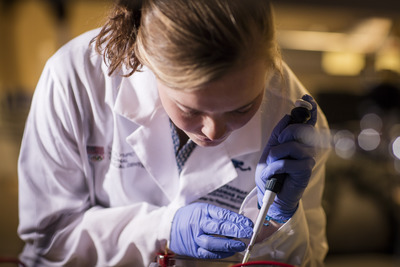Predictive Modeling and Personalized Medicine

The Steadman Philippon Research Institute and The Steadman Clinic have collected data on more than 33,000 surgical procedures for more than two decades.
SPRI’s doctors have used the outcomes of SPRI research to vastly improve the care of their patients, as well as to share their findings through publications and international conferences.
The database relies heavily, but not entirely, on patient response to surveys. The information is collected on every patient, not just those enrolled in special studies. Other data are produced, for example, during surgery, through imaging, laboratory studies, physical examinations, and patient histories.
Now the Institute is beginning to use its constantly-growing database and other statistical tools not just to look at past results, but to predict future developments and outcomes. Biostatisticians like Grant Dornan, M.S., Director of the Center for Outcomes-Based Orthopaedic Research, are working with SPRI’s physicians to contribute to the emerging fields of predictive modeling and personalized medicine.
Predictive modeling may be used to better anticipate hospital readmission following certain types of surgery, patient progress and satisfaction, wait time in doctors’ offices, or predicting future medical conditions.
“Predictive modeling and personalized medicine go hand-in-hand,” says Dornan. “When a predictive model is developed, patient outcomes are linked mathematically to existing data on patient-specific variables and details about the injury and surgical procedure. Later this model can be used to predict those same outcomes based on the same patient-specific details for a new patient. Based on the this process, we have a better understanding of how various factors (or variables) contribute to the probability of certain risks.”
A MODEL TO EMULATE
A famous example of predictive modeling is the Framingham Heart Study, which began in 1948. At the time, little was known about the causes of cardiovascular disease (CVD) and stroke.
The objective of the study was to identify common factors that contribute to CVD by following its development over a long period of time in a large group of participants. The subjects had not yet developed recognizable symptoms of CVD, nor had they suffered a heart attack or stroke.
The researchers recruited more than 5,000 men and women between the ages of 30 and 62 from the town of Framingham, Massachusetts. They began extensive physical examinations and lifestyle interviews that would later be used to analyze common patterns related to CVD development.
The subjects have continued to return every two years for detailed medical histories, physical examinations, and lab tests. In 1971, the study enrolled a second generation of subjects—5,124 of the original participants' adult children and their spouses. Additional and more diverse study groups were established in 1994 and 2002.
PREDICTING THE DEVELOPMENT OF OSTEOARTHRITIS
“Unlike cardiovascular health, predictive modeling in orthopaedics is very young,” says Dornan. “But there are some studies we’d like to emulate, and one of them is the Framingham Heart Study.”
“SPRI is well-positioned in orthopaedic sports medicine to conduct similar studies,” continues Dornan. “We don’t have that degree of data (69 years), but we have a body of data that is very rare within our own field (25+ years). We want to do the best we can to achieve in orthopaedics, sports medicine, and regenerative medicine what Framingham accomplished in cardiovascular health.”
“We are very close to clinical impact through predictive modeling at SPRI,” adds Dornan. “Our first primarily predictive model is finished, the paper is being written, and it will be submitted for publication soon.”
Using pre-operative data, physical exam results, radiographic measurements, and other statistical information, SPRI’s researchers are on the verge of being able to better predict the development of osteoarthritis—the most common joint disorder in the United States.
Analytic tools can be used to educate and prepare patients for future health developments, and to help doctors make well-informed decisions regarding treatment of their patients. It can also assist patients to take charge of their health.
SPRI is planning to add a second biostatistician to its staff, which will be another step in bringing predictive modeling to the forefront of patient care. Increased staffing, in addition to sophisticated analytic tools, will accelerate the process of getting research results to doctors and their patients.
ENHANCING PERSONALIZED CARE
The Steadman Philippon Research Institute has consistently maintained an outcomes-based body of information. Now it is in an even stronger positon to use predictive modeling to help individuals avoid or lessen the effects of future medical conditions. “At SPRI, we want to be leaders in this effort,” says Dornan.

